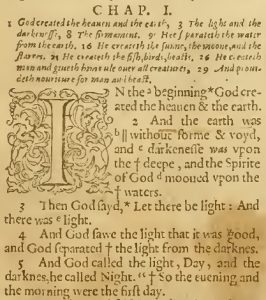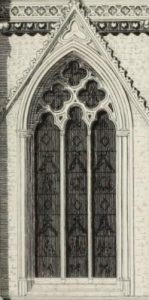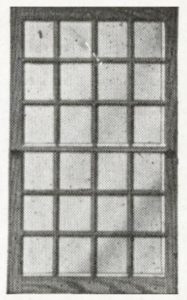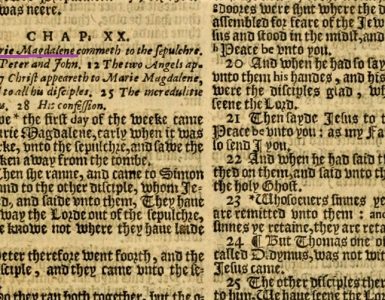In the colonial days of America congregations sometimes met outdoors for services because they did not have a building for worship. A group interested in having a church in their settlement gathered in the shade of a large tree or under the canopy of a forest or orchard. In at least one case a group of worshippers found the spacious mouth of a cave a convenient spot to hold services, which may have been a location that came to mind from the example of ancient Christians who fled persecution and lived in a cave city, including a church, in Cappadocia. Worship outdoors meant that having sufficient light was not a problem on a sunny day. Without getting pantheistic, there is something to be said for outdoor services, however, the obvious problems associated with changing seasons and weather conditions have proved it prudent to construct church buildings dedicated to worship. Any church building needs sufficient and reliable lighting.
 Light is often mentioned in the Bible not only because it physically pierces the darkness, but also because it spiritually illustrates good, righteousness, grace, and God’s presence. In the first chapter of Genesis it is said that “God separated the light from the darkness” (1:4). All things that were brought into existence by God during creation are described at the end of the process as “very good” (1:31), which would include the darkness, but when the light was created it was specifically said that the “light was good” (1:4). To eliminate total darkness during the night, God made the moon and stars to provide lesser but necessary illumination. If you have ever been in a photography darkroom with all the lighting turned off, you know how awful total darkness would be all night and every night.
Light is often mentioned in the Bible not only because it physically pierces the darkness, but also because it spiritually illustrates good, righteousness, grace, and God’s presence. In the first chapter of Genesis it is said that “God separated the light from the darkness” (1:4). All things that were brought into existence by God during creation are described at the end of the process as “very good” (1:31), which would include the darkness, but when the light was created it was specifically said that the “light was good” (1:4). To eliminate total darkness during the night, God made the moon and stars to provide lesser but necessary illumination. If you have ever been in a photography darkroom with all the lighting turned off, you know how awful total darkness would be all night and every night.
Turning to the New Testament, especially the books by the Apostle John, light and dark are used metaphorically for righteousness and sin, good and evil, or belief and unbelief. John 3:19-21 provides an extended use of light and dark, it might even be considered a bit like a parable because the story of light versus darkness illustrates the spiritual truth of belief against unbelief.
…the light has come into the world, and people loved the darkness rather than the light because their works were evil. For everyone who does wicked things hates the light and does not come to the light, lest his works should be exposed. But whoever does what is true comes to the light, so that it may be clearly seen that his works have been carried out in God. (ESV)
Just as physical light exposes all it illumines, so the light of God’s Son, the Word become flesh, exposes sin. John goes on in his first epistle to use light and dark to illustrate obedience versus disobedience, “If we say we have fellowship with him while we walk in darkness, we lie and do not practice the truth” (1:6). The Bible begins with creation of the heavenly bodies to bring light for the day and lesser light for the night, but in John’s vision in Revelation the Holy City will not need these sources of light because “night will be no more. They will need no light of lamp or sun, for the Lord God will be their light” (22:5). After all, “God is light, and in him is no darkness at all” (1 John 1:5).
 The revolution initiated by Thomas Edison’s incandescent light bulb has progressed and electric lights have improved considerably. Today, types of electric lighting, their methods of control, and greater efficiency of operation have exceeded anything that Mr. Edison could have imagined. So long as it is within the finances of a church as governed by its sense of proper stewardship, just about any level or quality of illumination can be achieved with electric lighting. An assortment of fixtures which use a variety of devices such as incandescent, fluorescent, and light emitting diodes (LED) might be used to brighten new churches or retrofit one needing updating.
The revolution initiated by Thomas Edison’s incandescent light bulb has progressed and electric lights have improved considerably. Today, types of electric lighting, their methods of control, and greater efficiency of operation have exceeded anything that Mr. Edison could have imagined. So long as it is within the finances of a church as governed by its sense of proper stewardship, just about any level or quality of illumination can be achieved with electric lighting. An assortment of fixtures which use a variety of devices such as incandescent, fluorescent, and light emitting diodes (LED) might be used to brighten new churches or retrofit one needing updating.
There are a few aspects that might be considered for the artificial lighting of a church. In the past, particularly in the later Victorian era and into the early twentieth century, candle, oil, gas, and early electric lighting generally could not provide evenly distributed quality general illumination for reading. The problem was exacerbated by dark interior finishes and the limited amount of light coming through stained-glass windows. Any older church with a dark interior can be enhanced not only by better lighting but also by brightening its walls, ceiling, and floor with more reflective finishes to improve the distribution of light. Some of the old wood panels and joinery of the church could be painted to brighten the room and reflect light better. The cost of improving lighting in an older church is high, but it may be that lighting consultants could provide insight into how to have better illumination at a lower price while maintaining the church’s historic feel at a lower price.
Since light is a good thing and symbolic of God’s presence, then its use in church design should be considered carefully. Church buildings should not only be places where spiritual light flows from the pulpit with a faithful exposition of God’s Word, but it seems appropriate that churches be places of physical light. Churches should be, as much as possible with stewardship in mind, well lit.
When building a new church its general lighting should be sufficient for easy reading of the Bible, hymnals, handout sheets, and digital devices. In the case of areas for choirs, the amount of light could be increased with localized fixtures to facilitate reading the notes and words of complex music. Churches are to emphasize the preaching of the Bible and administration of the sacraments in worship, so individually switched spot lights could be focused on the pulpit (not too much, the minister should not need sunglasses), on the table for the Lord’s Supper, and another to focus on the baptismal font. If there are locations for a piano, organ, or other accompaniment, the musicians would appreciate sufficient lighting to read their music along with their colleagues in the choir. Lighting controls begin with the simple two-way switch and extend to dimmers and more sophisticated devices. Something else to consider is if a church has high ceilings the changing of bulbs will require the use of a ladder or a telescoping bulb changing tool. Some modern illumination devices rarely need changing, but they will fail at some point.
 Artificial lighting has to be paid for up front during church construction and then it has to be fed with a steady diet of costly electricity. Many eighteenth and early nineteenth century churches in this country had large windows to provide light for bright sanctuaries, but of course, this method of lighting was at its best when the weather was agreeable. Light entering windows is not free because it increases the load on the air conditioning system, its ultraviolet rays can degrade fabrics and darken wood finishes over time, and if the sun happens to shine through a window such that it bothers people with glare, then that can be a problem as well. Modern window glass is available with coatings, films, and infused substances that reduce heat gain and loss while limiting the damage and degradation caused by ultraviolet light. However, returning to the brief Bible survey regarding light and dark, the sun is a good thing and it is a reminder of the future of the church in a place where there is no darkness and the Lord is the only light. The judicious and tasteful use of windows in church design can be a good thing.
Artificial lighting has to be paid for up front during church construction and then it has to be fed with a steady diet of costly electricity. Many eighteenth and early nineteenth century churches in this country had large windows to provide light for bright sanctuaries, but of course, this method of lighting was at its best when the weather was agreeable. Light entering windows is not free because it increases the load on the air conditioning system, its ultraviolet rays can degrade fabrics and darken wood finishes over time, and if the sun happens to shine through a window such that it bothers people with glare, then that can be a problem as well. Modern window glass is available with coatings, films, and infused substances that reduce heat gain and loss while limiting the damage and degradation caused by ultraviolet light. However, returning to the brief Bible survey regarding light and dark, the sun is a good thing and it is a reminder of the future of the church in a place where there is no darkness and the Lord is the only light. The judicious and tasteful use of windows in church design can be a good thing.
I have run across a few churches in my time that had some creative features. One church in a tropical location had a traditional layout within the sanctuary, but the two side walls were made entirely with sliding glass doors and screens. The doors could be opened and the screens closed for a breeze during a cool day or evening worship service. In order to limit direct sunlight, trees were planted in rows along the walls so that the canopy acted as an awning and shaded the expanses of glass doors from direct sunlight and its heat. Churches in older cities are sometimes located in commercial districts in basements, or on the second or third floor of a street level business. Churches in basements generally have very little outside light coming through their small bin-style windows and in older buildings in particular the ceilings tend to be lower and confining. In one case, a basement church had installed a continuous run of lighting around the perimeter of the room at the top of the walls. The light washed the walls and not only improved their appearance but also gave the basement a generally brighter sunshine-like feel. Another city church in a similar situation was on the third floor of a business. It had windows on its street side. When the church took occupancy of the property it removed a closet that had used about forty percent of the window wall for one of its enclosing sides. The pastor commented to me that the demolition had been done to increase seating, but they received an unanticipated bonus with a brighter room during services. It was a simple and comparatively inexpensive remodel that provided a significant change.
 Tradition can be a very good thing but it tends to establish a paradigm that restricts thinking, so when lighting a church with creational and artificial light, think outside the box while remembering that the space outside the box is contained within the Scripture’s teaching regarding worship and ministry. And do not forget the civil government’s oversight through its fire, safety, electrical, and other codes. Electricity is a ready friend, but it is can also be hazardous, so lighting installations must be designed properly and installed by qualified electricians.
Tradition can be a very good thing but it tends to establish a paradigm that restricts thinking, so when lighting a church with creational and artificial light, think outside the box while remembering that the space outside the box is contained within the Scripture’s teaching regarding worship and ministry. And do not forget the civil government’s oversight through its fire, safety, electrical, and other codes. Electricity is a ready friend, but it is can also be hazardous, so lighting installations must be designed properly and installed by qualified electricians.
The previous articles in the series on church design have each been illustrated with multiple examples, but in the case of this article, I really do not have pictures that display how churches are lit inside and the windows in my pictures tend to fall into the categories of stained glass and large and small divided lite units.
Barry Waugh
Sources—The image of the light bulb is from, Edison and His Inventions, edited by J. B. Mclure, Chicago: Rhodes & McClure Publishing Company, 1889, as digitized on Internet Archive, and the window images were found in catalogs on Internet Archive. The image of outdoor worship is actually a communion season gathering located in Nevin’s Presbyterian Encyclopedia. These people may or may not have had a church building and they may or may not all be Presbyterians. It is the closest image of what I wanted to illustrate that I could locate. I doubt an elevated pulpit would have been constructed for weekly outdoor worship services.





